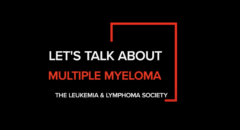
Brought to you in partnership with the Multiple Myeloma Research Foundation
Learning that you’ve been diagnosed with multiple myeloma can be overwhelming. Luckily, multiple myeloma is a highly treatable disease. Meaning thousands of patients are living long and productive lives after diagnosis. Both survival and quality of life for myeloma patients are constantly improving. The first step is to understand what form of multiple myeloma you have, and what the best treatment option is for you.
Knowing the classification of your disease is very important in deciding when it is appropriate to begin treatment and what treatment is best for your condition. Classification also plays an important role in determining the stage of multiple myeloma. Many Blacks may not always be presented with the best care, so it’s important that you are knowledgeable of the different stages and the best treatment options available for each.
Precursor Conditions
Monoclonal gammopathy of undetermined significance (MGUS)
MGUS is a plasma cell neoplasm diagnosed when a small amount of M protein is detected in the blood, but no other criteria for a solitary plasmacytoma or multiple myeloma diagnosis (such as a tumor, multiple lesions or symptoms) are present. MGUS occurs in about 1% of the general population.
MGUS usually does not cause any problems or require treatment, but in rare cases (1%-2%), it can develop into multiple myeloma. People living with MGUS receive regular checkups to ensure that it does not progress.
Smoldering (or asymptomatic) multiple myeloma
Smoldering multiple myeloma (SMM) is a precancerous form of multiple myeloma that typically accounts for about 15% of newly diagnosed multiple myeloma cases. It is diagnosed when low levels of M protein are found in the blood and a slightly increased number of plasma cells are found in the bone marrow. Many patients with SMM are asymptomatic, but some experience modest symptoms, such as mild anemia or a few small bone lesions.
The risk of progression is about 10% each year for the first 5 years following diagnosis, 3% between years 5 and 10 and about 1% in subsequent years. The most common approach to treating this type of myeloma has been “watchful waiting” to see if you are at high risk for developing active myeloma. However, studies have shown that early intervention demonstrates success in preventing multiple myeloma development for people that are at a higher risk for the disease. Early intervention means people with this asymptomatic cancer will be able to receive treatment early instead of waiting until they see symptoms.
Early intervention for SMM patients is done through clinical trials if the patient is considered high risk.
Multiple Myeloma Classifications
Solitary (or isolated) plasmacytoma
A single group of malignant myeloma cells (rather than multiple lesions, as in multiple myeloma) is called a “solitary plasmacytoma.” This mass of cells makes up 5% of plasma cell disorders. Isolated plasmacytoma of the bone can affect any bone, but tends to occur most frequently in the bones along the spinal column.

It is commonly treated with radiation therapy and rarely requires surgery. Prognosis with radiation alone is usually excellent, but there is a risk that a solitary plasmacytoma could recur and progress to multiple myeloma. People with a solitary plasmacytoma will have long-term follow-up appointments to ensure they remain in remission.
What is Multiple myeloma
Multiple myeloma is a type of cancer that affects plasma cells, causing them to grow out of control, usually inside the bone marrow. The “multiple” in multiple myeloma indicates that there are multiple tumors in different areas of the bone(s). More than 90% of individuals diagnosed with multiple myeloma have multiple tumors at the time of diagnosis.
Characteristics of multiple myeloma include elevated levels of M protein in the serum and/or urine, a percentage of plasma cells in the bone marrow over 30%, anemia, renal failure, hypercalcemia and osteolytic lesions. Management of multiple myeloma includes immediate treatment with myeloma drugs, bisphosphonates for patients with bone loss and options for clinical trials. Non-intensive treatment is more common and typically used on older or more frail patients. While intensive treatment is used on younger, more fit patients and involves higher doses followed by a stem cell transplant, a great deal of progress in myeloma patient care has been made in the last 10 years. The FDA has approved over a dozen new myeloma drugs since 2003. There is no shortage in the number of clinical trials for myeloma patients. MMRF is the leading funder of multiple myeloma research and has funded more than 80 clinical trials in recent years. If you need help finding a clinical trial, the MMRF Clinical Trial Finder can help you find the right fit.
Finding the Best Multiple Myeloma Treatment
Depending on the classification of your disease, as well as other factors, you may not have to receive treatment immediately. In some cases, postponing therapy may help avoid unnecessary side effects, the risk of complications associated with chemotherapy, and it may also delay the development of resistance to chemotherapy. If you are living with a precursor condition and decide to delay therapy, you can still receive supportive care to treat symptoms or complications.
READ: How Do I Know If My Multiple Myeloma Treatment Is Working?
For newly diagnosed myeloma patients, initial treatment usually consists of induction, or front-line therapy, which is meant to decrease disease burden to a very low or even undetectable level. Which induction therapy your care team recommends depends on whether you are a candidate for autologous stem cell transplant. If you have questions about which treatment is right for you, the MMRF Patient Navigation Center can provide additional information.
There are currently no cures for multiple myeloma, however, there are many research studies being conducted to find one. However, the MMRF CureCloud ® –the largest and most comprehensive database of its kind in myeloma — leverages scientist, doctor, and patient information to find treatments, improve patient quality of life and ultimately develop cures.
Ultimately, your treatment goals may differ from the next person. This is your journey. It is important to make sure that you are comfortable with your doctor and that you are provided with the best treatment method for your condition.
It’s also important to remember that:
- Precursor conditions to myeloma can be managed with early treatment.
- Treatments have made serious progress in recent years if you develop multiple myeloma.
- The right treatment for you is key. The MMRF can help you and your doctor with additional information.








